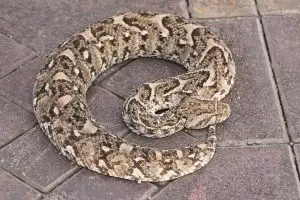Rattlesnakes can be quite scary, and their venom can cause severe health problems. Fortunately, there are ways to scare them off when they appear in front of you. Here are 5 things you can do to keep yourself safe when you come across one.
1. Throw Rocks Or Sticks In Their Direction
If you throw rocks or sticks in a rattlesnake’s direction, it could scare them off. This is especially effective if you make loud noises as well. Be careful not to get too close, as they could still strike even if they’re scared.
2. Stomp the Ground
Snakes respond to vibrations that alert them to predators or nearby dangers. Snakes cannot hear the way we do, but they are very sensitive to vibrations through the ground. Stomping the ground or beating the ground with a rock or piece of heavy wood could get the rattlesnake to back off and move away.
Any object heavy enough to bang on the ground can work, such as a book, coffee mug, or sticks. Stomping your feet 10 feet away from the snake might scare it away long enough for you (and it) to escape. This is probably the easiest way to scare away a rattlesnake if you’re not carrying any tools with you.
Just remember: don’t stomp too close to a rattlesnake! If you’re less than 6 feet away, or it’s moving toward you, then move back out of its strike range beforehand.
3. Wave Your Arms Around
Rattlesnakes do not have very good eyesight, but if you are close and wave your arms around, the snake can get afraid and decide to leave. Waving your arms also makes it more difficult for the snake to target you with a strike because it can become confusing.
4. Move The Rattlesnake Away With A Walking Stick
A riskier way to get rid of a rattlesnake is to try and move it with a walking stick or long tree branch. Wear gloves if you have them. Grab the stick near the end and prod at the snake until it moves off in the opposite direction. Be very careful not to get too close to its head.
5. Use A Snake Repellent
Rattlesnakes do not like snake repellent, and spraying one nearby to one will likely cause it to slither away. This is a great way to scare away rattlesnakes without harming them. You can buy snake repellent at most hardware stores.
It is best to try not to scare a rattlesnake, as it could make them defensive and strike. However, if you feel you need to, with any luck, these scare tactics will work and the rattlesnake will slither away!
This video gives more useful information on how to scare rattlesnakes away:
Recommended Snake Repellents
Harris Snake Repellent Spray for Indoor and Outdoor Use
Exterminator’s Choice – Snake Defense Spray – 32 Ounces – Natural, Non-Toxic Snake Repellent
Always Be Cautious In Rattlesnake Territory
Rattlesnakes have a wide territory they can inhabit across the continent. According to the National Parks Service, they can be found in every U.S. state except for Alaska and Hawaii, rattlesnakes are a part of life in many areas, so it’s important to be cautious when hiking or camping in their territory.
Rattlesnakes have fairly poor vision and prefer to avoid people. If you are in their territory, it is best to keep away from them. They could be on your path simply because they are out sunbathing, resting, or looking for an easy meal.
The seasons where you will most likely run across them are in the early spring through the fall. Watch out for tall grasses and large rocks as these are the places rattlesnakes are most likely hiding. If you are traversing their space in wintertime, they have likely hidden away hibernating.
If you manage to scare away a rattlesnake, or it decides to move along, just give it space so it can do so. The last thing you want to do is to corner a rattlesnake or make it afraid.
To Close
The best way to keep rattlesnakes away is to not get too close to them in the first place. Another is to limit any reason they would want to get close to you, such as removing nearby food sources. Just remember, the reason for putting in the effort is to maintain your safety while you enjoy hiking, camping, fishing, or strolling around your property.


